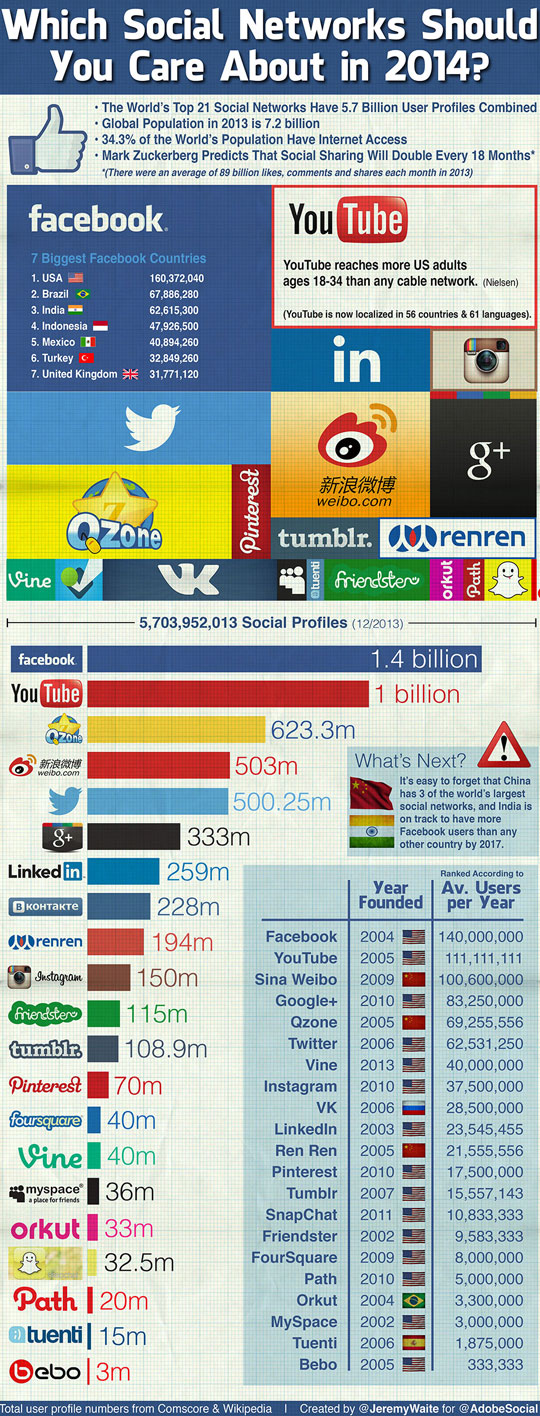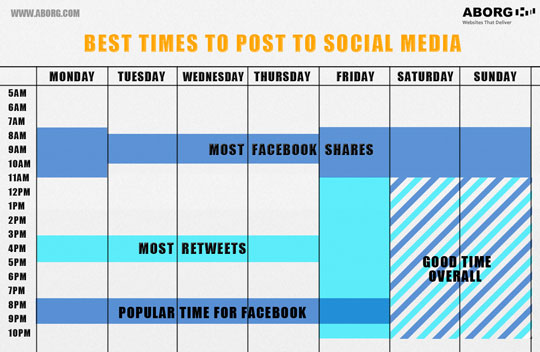Social Media is no longer a “just for fun” activity. It’s no longer a place for college students to share party photos and connect with mindless chatter. For brands looking to succeed, to get ahead and to make an impact on a target market, social media marketing is essential; it should be considered just as important – if not more so – as any other marketing strategy or campaign element.
The statistics make it clear that there is a lot at stake. Illustrated in the Infographic below, more people can be found on social networks than inside of some of the world’s largest countries.
The top networks, Facebook and YouTube each boast over one billion users, and are each capable of reaching larger audiences than any television network or other online endeavor. With the recognized social networks boasting over 5.7 billion profiles coupled with the notion that social sharing is predicted to double in exponential growth every 18 months, brands looking to stay ahead must compete in the social media arena.
For many companies, this means hiring a social media marketer or working with a consultant, which is where you come in. As a social media expert, it’s your job to take your employer or clients to the next level; to help them stand out among a sea of social media influences while reaching targeted audiences with strategic, precise campaigns. Sounds great, right? Sure. Maybe even simple; that’s when it becomes time to evaluate your approach.
While social networks are designed to be user-friendly and easy to use, they are not exempt from marketing challenges. In fact, to be a successful social media manager, a constant search for knowledge coupled with business savvy and solid instincts are vital qualities.
There are also ways to cripple a social media campaign, sometimes before it even starts.
Let’s take a look at the five deadly sins for the social media manager
Take note and avoid them at all costs; your success may depend upon it.
1. Selfishness
Yes, the goal of any social media campaign is to promote a specific brand, cause or idea. That’s why brand pages are created in the first place. Does this give you an open opportunity to promote your brand or your client’s brand shamelessly while paying no attention to the community that surrounds it? Absolutely not.
Just like real life, people join social networks to connect, interact and get something for themselves. Think about your target network; what drives them? Would calling them out, posting photos or providing useful tips be appreciated? What about taking the time to encourage them to share information that matters to them, following them or liking what they share? Selflessness online can take on any number of forms, but selfishness stands out; avoid it at all costs.
Creating an environment based upon selflessness means better overall perception, better perception leads to faithful followers, faithful followers can become brand ambassadors, which takes online marketing to the next level. Brand ambassadors are motivated by two-way conversations and stable online habitats. Check out the tips below for best results.
2. Hit And Run Posting
Coupled with selfishness, hit and run social media marketing is a key ingredient in disaster. Far too often, brands, especially larger brands, post status updates, Tweet questions or Instagram photos, then disappear until it’s time to post something new. In the meantime, customers may react, ask questions or require further explanation. When this pattern occurs repeatedly – the sharing of content and information with a lack of follow through – customers fail to engage. They know you will not respond, so they don’t waste their energy. Eventually, they may stop visiting your page in the first place.
As Danielle Smith, co-author of Social Media Engagement explains in the video below, engagement is a two-way street. Hit and run posting works directly against this objective.
3. Shady Techniques
It may sound outrageous, but it’s a common practice. There are some questionable tactics social media brand managers consider on a regular basis. These include – but are not limited to – buying followers and fans, spamming groups for votes, not following through on contests or contest prizes and sharing user information.
It’s a fine line. For the most part, those who participate in social networks are willing to share some information that would otherwise be kept private. Think of it like an exchange; customers open up to you or your brand because they want to build a relationship to do business either now or in the future. When they are exposed to questionable marketing tactics or dishonesty, the relationship could be demolished before it begins.
Transparency is important for brands looking to build an online following. Be honest at all times.
4. Inactivity
For the most part, social media networks function on a central feed. Users log into their accounts and are exposed to the most recent posts by their friends and the brands they follow. Those who post most frequently and at the right times are the more likely to attract attention – which should be your goal as a social media marketer.
By failing to make social media part of your daily routine or creating a page and abandoning it, you’re doing your brand and your community a great disservice. In many cases, it’s better to not have a social media presence at all then to have one with a lack of activity – when searchers come across an abandoned page, they’re more likely to move onto a competitor.
If you create a social media account, stick to it.
While there may be lulls in activity levels, failing to make an effort is inexcusable.
The following graphic by Aborg shows data from HubSpot and other sources that have discovered and tested the best times to post on Facebook and Twitter to get the most engagement and views.
5. Forgetting About Metrics
Any marketing campaign should be a targeted, strategic effort, this includes social media marketing. Most networks equip users, especially page managers, with built-in metrics and analytics tools to ensure the highest level of precision, website traffic and overall conversions. Because the purpose of a social media marketing campaign should be driving traffic and conversions, this is essential.
Take the time to learn about the networks you use for marketing.
Take a look at the analytics they provide. Look back at your past efforts and take note of what has been most successful. If your customers respond to certain post types, or posts at certain times of day, make an effort to replicate those actions. If certain measures fall flat, consider eliminating them from your campaign. Track impressions, shares, likes, comments and Retweets when applicable.
By taking the time to measure your efforts, you’re leaving room for growth. Failing to do so could mean a stagnant social media campaign that never gets off the ground.
While this is in no way a comprehensive list of things to avoid as a social media manager, it’s a starting point.
Take the five deadly sins above to heart and rethink your future social media activities.
[Image credits – Main Photo by cody berg from Pexels; Infographic: @JeremyWaite; Best times to post: Aborg]
Alicia is a PR specialist for a tech company and blogs in her free time at MarCom Land. Her articles have been published by the Hot in Social Media, Yahoo! Small Business, and Social Media Today.



Comments are closed.